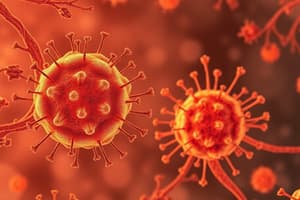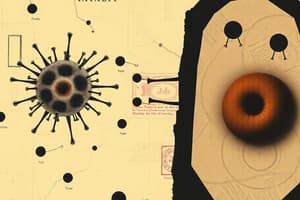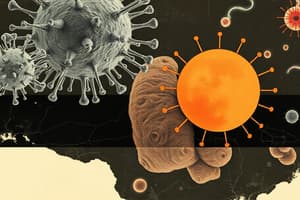Podcast
Questions and Answers
What is the primary consequence of CD8+ T cells interacting with MHC class I molecules?
What is the primary consequence of CD8+ T cells interacting with MHC class I molecules?
- Increase in antibody production
- Activation of helper T cells
- Release of cytokines
- Death of the presenting cell (correct)
Which cytokine is primarily associated with the activation of helper T cells when they recognize MHC class II?
Which cytokine is primarily associated with the activation of helper T cells when they recognize MHC class II?
- IL-10
- IL-2 (correct)
- TNF-alpha
- IFN-gamma
Which of the following correctly describes the structure of TCR?
Which of the following correctly describes the structure of TCR?
- One heavy and one light chain only
- Four identical chains held by peptide bonds
- Two chains typically marked as alpha and beta (correct)
- Two identical heavy and two identical light chains
Which MHC class molecules are known to be expressed on all nucleated cells?
Which MHC class molecules are known to be expressed on all nucleated cells?
What is the main function of dendritic cells in the immune response?
What is the main function of dendritic cells in the immune response?
The generation of diversity in TCR and BCR is primarily a result of which process?
The generation of diversity in TCR and BCR is primarily a result of which process?
Which of the following genes are classified under MHC class II in humans?
Which of the following genes are classified under MHC class II in humans?
What happens to immature T cells that recognize self-peptides in the thymus?
What happens to immature T cells that recognize self-peptides in the thymus?
What role do dendritic cells play in the adaptive immune response?
What role do dendritic cells play in the adaptive immune response?
Which of the following best describes MHC Class II molecules?
Which of the following best describes MHC Class II molecules?
What is a key feature of T Cell Receptor (TCR) diversity?
What is a key feature of T Cell Receptor (TCR) diversity?
Which statement is true regarding MHC Class I molecules?
Which statement is true regarding MHC Class I molecules?
What is the function of T helper cells during T cell activation?
What is the function of T helper cells during T cell activation?
Which class of antibodies is typically produced first in an immune response?
Which class of antibodies is typically produced first in an immune response?
Which of the following mechanisms do natural killer (NK) cells utilize to recognize antibody-coated cells?
Which of the following mechanisms do natural killer (NK) cells utilize to recognize antibody-coated cells?
What occurs during the process of isotype switching in B cells?
What occurs during the process of isotype switching in B cells?
What are the three signals required for the activation of T cells?
What are the three signals required for the activation of T cells?
Which signal is NOT involved in the activation of B cells?
Which signal is NOT involved in the activation of B cells?
What is the primary function of MHC Class II in B cell activation?
What is the primary function of MHC Class II in B cell activation?
Which component is NOT a part of the receptor on T cells?
Which component is NOT a part of the receptor on T cells?
Which statement about dendritic cells is true in the context of T cell activation?
Which statement about dendritic cells is true in the context of T cell activation?
What is the role of CD40L in B cell activation?
What is the role of CD40L in B cell activation?
What distinguishes MHC Class I structure from MHC Class II?
What distinguishes MHC Class I structure from MHC Class II?
During the activation of B cells, what happens after antigen recognition by BCR?
During the activation of B cells, what happens after antigen recognition by BCR?
list the pashes of adaptive immunity?
list the pashes of adaptive immunity?
what are naive lymphocytes?
what are naive lymphocytes?
what would the binding of T and B cells to antigens lead to?
what would the binding of T and B cells to antigens lead to?
what is the function of B cells?
what is the function of B cells?
what is the function of helper T cells?
what is the function of helper T cells?
what's the function of Cytotoxic T cells?
what's the function of Cytotoxic T cells?
what type of immunity block infections and eliminate extracellular microbes?
what type of immunity block infections and eliminate extracellular microbes?
what r the immune cells that activate phagocytosis to kill microbes?
what r the immune cells that activate phagocytosis to kill microbes?
what type of immune cells involved in killing infected cells and eliminate reservoirs of infection?
what type of immune cells involved in killing infected cells and eliminate reservoirs of infection?
what's the function of memory cells?
what's the function of memory cells?
what does TCR and BCR stand for?
what does TCR and BCR stand for?
what type of receptor has alpha and beta chain?
what type of receptor has alpha and beta chain?
what type of receptor has light and heave chain?
what type of receptor has light and heave chain?
what type of receptor involved in a direct recognition of an antigen?
what type of receptor involved in a direct recognition of an antigen?
describe 2 ways that TCR can recognise antigen (foreign proteins)?
describe 2 ways that TCR can recognise antigen (foreign proteins)?
what's MHC?
what's MHC?
which acts as a co-receptor for MHC class I?
which acts as a co-receptor for MHC class I?
which acts as a co-receptor for MHC class II?
which acts as a co-receptor for MHC class II?
what's the outcome of MHC class I pathway?
what's the outcome of MHC class I pathway?
what's the outcome of the MHC class II pathway?
what's the outcome of the MHC class II pathway?
in which pathway does the digestion of protein in proteasomes occur?
in which pathway does the digestion of protein in proteasomes occur?
in which pathway does the endocytosis of (extracellular) protein/pathogen occur?
in which pathway does the endocytosis of (extracellular) protein/pathogen occur?
list the 3 classical MHC class I genes in humans?
list the 3 classical MHC class I genes in humans?
list the main MHC class II genes in humans?
list the main MHC class II genes in humans?
MHC class II is expressed by?
MHC class II is expressed by?
what cells r considered as ( professional antigen presenting cell)?
what cells r considered as ( professional antigen presenting cell)?
describe the role of DCs as an antigen presenting cell?
describe the role of DCs as an antigen presenting cell?
which part of the TCR structure interacts with the antigen?
which part of the TCR structure interacts with the antigen?
what generates the variable domains of BCR and TCR?
what generates the variable domains of BCR and TCR?
where does the negative selection (t-cells) occur?
where does the negative selection (t-cells) occur?
what type of cells undergo receptor editing/apoptosis in bone marrow?
what type of cells undergo receptor editing/apoptosis in bone marrow?
what receptors involved in the co-stimulatory signal in T-cell activation?
what receptors involved in the co-stimulatory signal in T-cell activation?
briefly label the three signals of T cell activation?
briefly label the three signals of T cell activation?
label the B cell activation signals
label the B cell activation signals
what receptors involved in B&T cells interaction/co-stimulation?
what receptors involved in B&T cells interaction/co-stimulation?
site of immune cells generation?
site of immune cells generation?
site of lymphocytes interaction w ag?
site of lymphocytes interaction w ag?
where does antigen in blood go to?
where does antigen in blood go to?
where does antigen in tissue/periphery go to?
where does antigen in tissue/periphery go to?
what's the collection of T and B cells in the node where formation of mature,effector T&B cells occur?
what's the collection of T and B cells in the node where formation of mature,effector T&B cells occur?
encapsulated highly vascular organ that filters blood, eliminate pathogens, also has follicles for B-T maturation/activation?
encapsulated highly vascular organ that filters blood, eliminate pathogens, also has follicles for B-T maturation/activation?
what's the first antibody produced?
what's the first antibody produced?
which antibody involved in Opsonisation?
which antibody involved in Opsonisation?
what receptors triggers/activate phagocytosis ?
what receptors triggers/activate phagocytosis ?
what receptor does NK cell express?
( that allows recog and killing of antibody-coated cell).
what receptor does NK cell express? ( that allows recog and killing of antibody-coated cell).
what cells inhibit immune response?
(important in self-tolerance).
what cells inhibit immune response? (important in self-tolerance).
Flashcards
Antigen Presenting Cell (APC)
Antigen Presenting Cell (APC)
A cell that displays antigens on its surface to activate T cells.
Lymphoid Follicles
Lymphoid Follicles
Collections of B and T cells in lymph nodes and spleen, responding to specific antigens.
Germinal Center
Germinal Center
The area in lymphoid follicles where activated B and T cells proliferate and mature.
Antibody Isotype
Antibody Isotype
Signup and view all the flashcards
Antibody Isotype Switching
Antibody Isotype Switching
Signup and view all the flashcards
Cytotoxic T Cells
Cytotoxic T Cells
Signup and view all the flashcards
T Helper Cells
T Helper Cells
Signup and view all the flashcards
Memory Lymphocytes
Memory Lymphocytes
Signup and view all the flashcards
MHC Class I Pathway
MHC Class I Pathway
Signup and view all the flashcards
MHC Class II Pathway
MHC Class II Pathway
Signup and view all the flashcards
MHC Class I Expression
MHC Class I Expression
Signup and view all the flashcards
MHC Class II Expression
MHC Class II Expression
Signup and view all the flashcards
Dendritic Cells (DCs)
Dendritic Cells (DCs)
Signup and view all the flashcards
TCR (T cell receptor)
TCR (T cell receptor)
Signup and view all the flashcards
BCR/Antibody Structure
BCR/Antibody Structure
Signup and view all the flashcards
Negative Selection (T cells)
Negative Selection (T cells)
Signup and view all the flashcards
B cell activation signals
B cell activation signals
Signup and view all the flashcards
B cell receptor (BCR)
B cell receptor (BCR)
Signup and view all the flashcards
Helper T cell activation
Helper T cell activation
Signup and view all the flashcards
Co-stimulation
Co-stimulation
Signup and view all the flashcards
Primary lymphoid tissue
Primary lymphoid tissue
Signup and view all the flashcards
Secondary lymphoid tissue
Secondary lymphoid tissue
Signup and view all the flashcards
Lymphocyte trafficking
Lymphocyte trafficking
Signup and view all the flashcards
Receptor editing
Receptor editing
Signup and view all the flashcards
Study Notes
Adaptive Immunology
- Adaptive immunity is a feature of the immune system involving antigen presentation, lymphocyte activation, B cell effector function, T cell effector function, and memory.
- A microbe is initially encountered by the innate immune system (hours).
- B and T lymphocytes (days) specifically recognize and target a pathogen, producing an antibody response.
- Antigen is any molecule recognized specifically by lymphocytes or antibodies.
- Naive lymphocytes: mature T or B cells never encountering foreign antigen.
- T and B cells bind to specific antigens. This leads to their activation, proliferation, and differentiation.
- Adaptive immunity is mediated by T and B cells.
Phases of Adaptive Immunity
- Antigen recognition, lymphocyte activation, antigen elimination, contraction (homeostasis), and memory phases.
- Antigen recognition is followed by differentiation causing clonal expansion of naive T cells and naive B cells.
- Antibody-producing cells and effector T cells eliminate the antigen,
- The immune response contracts (homeostasis)
- Memory cells remain to aid future immune response
Functions of Adaptive Immunity
- B cells: mediate humoral (soluble) immunity by producing antibodies.
- Helper T cells: interact with other immune cells to direct an effective response.
- Cytotoxic T cells: kill infected or malignant host cells.
Memory in the Adaptive Immune System
- After infection resolution, memory cells remain.
- These aid in faster response during future infection and lessen the disease severity.
- Secondary response is much faster and involves less antigen than a primary response.
TCR and BCR
- TCR (T-cell receptor): antigen-binding site, variable regions, constant regions, transmembrane regions, alpha and beta chains.
- BCR (B-cell receptor): antigen-binding site, light chain, heavy chain, transmembrane region.
- BCR directly recognizes antigen.
- TCR does not directly recognize antigen, instead proteins must be processed into peptides and presented in MHC for T cell recognition.
Antigen Presentation
- T cells cannot directly recognize foreign proteins.
- Proteins must be processed into peptides and presented with major histocompatibility complex (MHC) molecules.
- MHC class I pathway occurs in intracellular pathogens where the foreign protein is made inside the host cell.
- MHC class II pathway occurs in extracellular pathogens where the foreign protein is taken up.
MHC Class I Pathway
- Foreign proteins made inside the presenting cell are presented on MHC class I molecules.
- These molecules are recognized by cytotoxic T cells which have the CD8 marker acting as a coreceptor.
- This leads to death of the presenting cell.
MHC Class II Pathway
- Foreign proteins taken up by the presenting cell are presented on MHC class II molecules.
- These molecules are recognized by helper T cells which have the CD4 marker acting as a coreceptor.
- This leads to activation of the helper T cell.
Dendritic Cells
- Play a central role in processing and presenting antigen.
- They're professional antigen-presenting cells (APCs), along with macrophages and B cells.
Diversity of TCR and BCR
- The variable domains are generated via recombination of gene segments.
- This high diversity allows for a large number of different receptors from a limited number of gene segments.
Negative Selection
- Random generation of BCRs/TCRs can result in recognition of self-antigens.
- Immature T cells recognising MHC molecules with self-peptides undergo apoptosis.
- In the bone marrow, B cells may undergo receptor editing or apoptosis.
Activation of Adaptive Cells
- T Helper cell activation: three signals needed (TCR - antigen recognition, co-stimulation by presenting cell, and cytokines). This leads to clonal expansion and differentiation.
- B cell activation: Requires three signals: BCR (antigen recognition), co-stimulation from Helper T cell, and cytokines.
B Cell-T Cell Interactions
- Co-stimulation results from CD40L on activated Helper T cell and CD40 on the B cell.
- Cytokines influence the antibody type produced.
Lymphocyte Trafficking
- Antigens from the tissue are delivered to the lymph nodes via lymphatics.
- Antigens in the blood are delivered to the spleen. Lymphoid tissue is where immune cells are generated and mature, includes bone marrow and thymus, as well as secondary locations like lymph nodes and spleen for antigen interaction.
Lymph Node
- Encapsulated organs throughout the body, transporting antigens from periphery through lymph.
- Antigen presenting cells deliver antigens to lymphoid follicles containing T & B cells.
- Proliferation leads to germinal center formation and maturation to effector T & B cells.
The Spleen
- Filters blood, eliminating blood-borne pathogens.
- Lymphocyte follicles generate germinal centers for antigen activation, leading to effector T & B cell generation.
Effector Functions of Adaptive Lymphocytes
- B cell function: Antigen recognition leads to plasma cells producing antibodies targeting the microbe. Antibody function involves neutralization, phagocytosis, and complement activation.
Antibody Isotypes
- There are five different antibody classes/isotypes (IgG, IgA, IgE, IgM, IgD).
- Differences in constant regions lead to different biological functions like complement fixation.
- IgM is the first antibody produced.
Antibody Isotype Switching
- Depending on the signal, B cells can switch from producing IgM to other isotypes such as IgG, IgE, or IgA.
- The switch depends on cytokine and receptor interactions with Helper T cells.
Antibody Isotype Differences
- Distinct functions (e.g., protection, allergies, etc.)
- Vary in locations in the body (plasma, secretions, mucosa etc.)
- Different molecular forms (monomer, dimer, pentamer, etc.).
Role of Antibodies
- Antibodies aid in microbe neutralization, phagocytosis, complement activation and cytotoxicity in innate immune cells, and other immune system processes.
Antibodies: Neutralisation
- Antibodies block microbe entry, preventing infection.
- They block toxins from binding to their target, neutralizing their effects.
Antibodies: Opsonization
- Antibody binding to microbes enhances phagocytosis by phagocytes.
Antibodies: ADCC
- Antibodies coating a cell target NK cells which then kill the antibody-coated cells.
T cell Function
- Helper T cells (CD4+): Activation, proliferation, differentiation of T and B cells.
- Cytotoxic T cells (CD8+): Killing of infected cells.
Cytotoxic T Cells
- These cells kill infected host cells.
- Their mechanism of cytotoxicity is similar to NK cells.
T Helper Cells
- Different types of T helper cells exist, depending on the environment and cytokines present.
- Treg cells (regulatory T cells) regulate the immune response and are important for maintaining self-tolerance.
T Helper Cell Subsets
- Different T helper subtypes (Th1, Th2, Th17) have specific cytokine profiles and target different cells (e.g., macrophages, eosinophils, neutrophils).
Memory
- Most lymphocytes die after an immune response, however memory cells persist.
- Memory cells reactivate much faster than naive T or B cells.
- Secondary response involves significantly less antigen and is much faster than primary response.
Studying That Suits You
Use AI to generate personalized quizzes and flashcards to suit your learning preferences.




